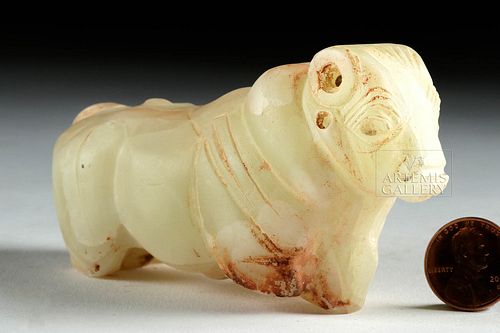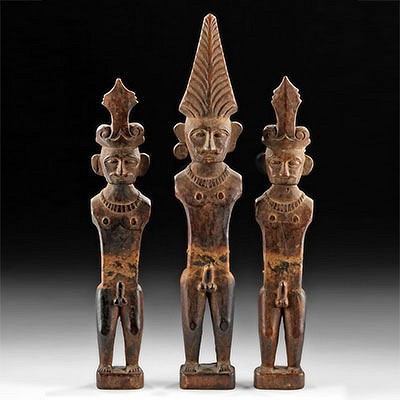Rare South Arabian Sabaen Alabaster Sculpture - Bull
Lot 55d
About Seller
Artemis Gallery
686 S Taylor Ave, Ste 106
Louisville, CO 80027
United States
Selling antiquities, ancient and ethnographic art online since 1993, Artemis Gallery specializes in Classical Antiquities (Egyptian, Greek, Roman, Near Eastern), Asian, Pre-Columbian, African / Tribal / Oceanographic art. Our extensive inventory includes pottery, stone, metal, wood, glass and textil...Read more
Categories
Estimate:
$1,500 - $2,000
Absentee vs Live bid
Two ways to bid:
- Leave a max absentee bid and the platform will bid on your behalf up to your maximum bid during the live auction.
- Bid live during the auction and your bids will be submitted real-time to the auctioneer.
Bid Increments
| Price | Bid Increment |
|---|---|
| $0 | $25 |
| $300 | $50 |
| $1,000 | $100 |
| $2,000 | $250 |
| $5,000 | $500 |
| $10,000 | $1,000 |
| $20,000 | $2,500 |
| $50,000 | $5,000 |
| $100,000 | $10,000 |
| $200,000 | $20,000 |
About Auction
By Artemis Gallery
Jun 25, 2020
Set Reminder
2020-06-25 10:00:00
2020-06-25 10:00:00
America/New_York
Bidsquare
Bidsquare : CLEARANCE - Ancient, Pre-Columbian, Ethno Art
https://www.bidsquare.com/auctions/artemis-gallery/clearance---ancient-pre-columbian-ethno-art-5264
Featuring discounted pricing on antiquities from Egypt, Greece, Italy, and the Near East...plus Viking, Asian, Pre-Columbian, Tribal, Russian Icons, Spanish Colonial, Fine Art, more! Starting prices have been reduced up to 65% from original auction prices - perfect for dealers and collectors. Artemis Gallery info@artemisgallery.com
Featuring discounted pricing on antiquities from Egypt, Greece, Italy, and the Near East...plus Viking, Asian, Pre-Columbian, Tribal, Russian Icons, Spanish Colonial, Fine Art, more! Starting prices have been reduced up to 65% from original auction prices - perfect for dealers and collectors. Artemis Gallery info@artemisgallery.com
- Lot Description
**Originally Listed At $1250**
Southern Arabia, around modern day Yemen, Sabaean people, ca. late 1st millennium BCE to early 1st millennium CE. An incredibly rare and finely carved alabaster bull. The muscular bovine is depicted in a prone position, although there are deliberately drilled perforations in each leg, suggesting that the artist created extensions, likely made from precious material, for this fellow to stand upon. His visage presents a high rounded forehead, ovoid eyes surrounded by incised arched markings that further accentuate his gaze, rounded ears with more drilled perforations perhaps for inserting horns, a detailed muzzle with more perforations in the cheeks, and strategically placed incised markings to delineate his fur. The genitalia and tail are also delineated, and another drilled perforation at the tail end suggests that there was once an inserted ornament or extension here as well. In addition to the skillfully rendered form, the alabaster itself is mesmerizing, presenting golden hues with some red pigmentation in areas and marvelous translucency. Size: 3.75" L x 2.125" H (9.5 cm x 5.4 cm)
During the first millennium BCE, this part of the world saw several kingdoms - Qataban, Saba (Sheba), and Himyar - emerge that had built their wealth upon desert trade and in particular frankincense and myrrh. The people of these kingdoms created many figural representations from alabaster and similar stones, many of which were flat panels with high relief faces depicting the dead and made to mark tombs. It is much rarer to find full three-dimensional statues in the round like this one, clearly intended to be viewed from all angles. They were most likely placed into tombs as votive offerings - acts of piety, designed to invoke the favor of a god, but also serving as public displays of wealth and status. Today they are fascinating not only for their haunting, clearly ancient beauty, but also for their symbolism. The bull was a very popular motif, because it was the symbol of Amm, the patron deity of the Qatabanians who believed that they were the progeny of Amm. The Qatabanians derived great prosperity from agriculture and the incense trade, but by the end of the second century CE their kingdom had declined and collapsed.
Provenance: private East Coast, USA collection; ex-William Froelich collection, New York and California (USA) and Saba (Caribbean), acquired in 1970s
All items legal to buy/sell under U.S. Statute covering cultural patrimony Code 2600, CHAPTER 14, and are guaranteed to be as described or your money back.
A Certificate of Authenticity will accompany all winning bids.
We ship worldwide and handle all shipping in-house for your convenience.
#143557Internal pressure fissures as shown. Wonderful translucency to the alabaster. Perforations at the ears, cheeks, legs, and tail - perhaps for inserted extensions, ornaments, or inlays made of precious materials.Condition
- Shipping Info
-
All shipping is handled in-house for your convenience. Your invoice from Artemis Gallery will include shipping calculation instructions. If in doubt, please inquire BEFORE bidding for estimated shipping costs for individual items.
-
- Buyer's Premium



 EUR
EUR CAD
CAD AUD
AUD GBP
GBP MXN
MXN HKD
HKD CNY
CNY MYR
MYR SEK
SEK SGD
SGD CHF
CHF THB
THB
















